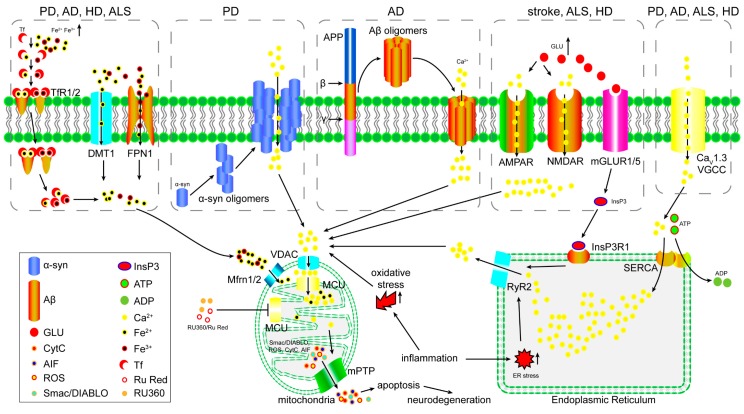Figure 2.
The proposed model of mitochondrial calcium dysregulation in neurodegenerative disorders and the potentiality of MCU as therapeutic target. Iron over-imported by TfR1/2, DMT1 and FPN1 will be taken up by mitochondria through Mfrn1/2 and potentially MCU. Excess calcium gets into cytoplasm through Aβ oligomers or α-syn oligomers formed ion channel, or glutamate receptors in pathological tissues of neurodegenerative disorders. InsP3R1 activation induce calcium release from ER. Continuous activation of L-type calcium channel CaV1.3 VGCC in PD, AD, HD and ALS. Excess calcium and iron in cytosol induce mitochondrial dysfunction, mPTP opening and pro-apoptosis factors release through MCU-mediated calcium and iron uptake. (PD: Parkinson’s disease; AD: Alzheimer’s disease; HD: Huntington’s disease; ALS: Amyotrophic lateral sclerosis; TfR1/2: transferrin receptor protein 1/2; DMT1: divalent cation transporter 1; FPN1: ferroportin-1; AMPAR: α-amino-3-hydroxy-5-methyl-4-isoxazolepropionic acid receptor; NMDAR: N-methyl-D-aspartate receptor; mGLUR1/5: metabotropic glutamate receptor 1/5; VGCC: voltage-dependent L-type calcium channel subunit β-2; VDAC: Voltage-dependent anion-selective channel; Mfrn1/2: mitoferrin 1/2: MCU: mitochondrial calcium uniporter; RyR2: ryanodine receptor 2; InsP3R1: inositol 1,4,5-trisphosphate receptor type 1; SERCA: Sarcoplasmic/endoplasmic reticulum calcium ATPase 2; GLU: glutamate; mPTP: mitochondrial permeability transition pore; CytC: cytochrome C; ROS: reactive oxygen species; AIF: apoptosis-inducing factor; Smac/DIABLO: Second mitochondria-derived activator of caspase/direct inhibitor of apoptosis-binding protein with low pI. ER: endoplasmic reticulum).

